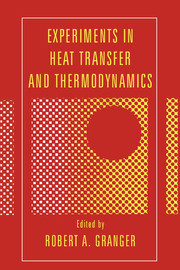Book contents
- Frontmatter
- Contents
- Preface
- Introduction
- Part I Experiments in heat transfer
- I.1 Conduction
- Experiment 1 Critical radius of insulation
- Experiment 2 The regelation of ice – the effect of heat conduction
- Experiment 3 Unsteady heat conduction in a sphere
- Experiment 4 Heat conduction in materials with nonhomogeneous structure
- Experiment 5 Measurement of thermal conductivity of solids during chemical reactions
- Experiment 6 Temperature measurements in a transparent material: Application of the holographic interferometry
- I.2 Convection
- I.3 Boiling
- I.4 Mixing, dispersion, and diffusion
- I.5 Radiation
- I.6 Heat pipes and exchangers
- Part II Experiments in thermodynamics
- Appendix 1 Experiments and demonstrations in thermodynamics
- Appendix 2 Experiments and demonstrations in heat transfer
- Appendix 3 Heat-transfer and thermodynamic films
- Index
Experiment 3 - Unsteady heat conduction in a sphere
Published online by Cambridge University Press: 05 June 2012
- Frontmatter
- Contents
- Preface
- Introduction
- Part I Experiments in heat transfer
- I.1 Conduction
- Experiment 1 Critical radius of insulation
- Experiment 2 The regelation of ice – the effect of heat conduction
- Experiment 3 Unsteady heat conduction in a sphere
- Experiment 4 Heat conduction in materials with nonhomogeneous structure
- Experiment 5 Measurement of thermal conductivity of solids during chemical reactions
- Experiment 6 Temperature measurements in a transparent material: Application of the holographic interferometry
- I.2 Convection
- I.3 Boiling
- I.4 Mixing, dispersion, and diffusion
- I.5 Radiation
- I.6 Heat pipes and exchangers
- Part II Experiments in thermodynamics
- Appendix 1 Experiments and demonstrations in thermodynamics
- Appendix 2 Experiments and demonstrations in heat transfer
- Appendix 3 Heat-transfer and thermodynamic films
- Index
Summary
Principle
One method of measuring thermal diffusivities of different solids is to immerse a sphere of the material in a hot (or cold) water bath, and to measure the temperature response at different points within the solid.
Objective
To provide a simple undergraduate experiment illustrating Fourier's Law for unsteady heat conduction.
Apparatus
A 5–8-cm-diameter sphere is used of the material whose thermal conductivity it is desired to measure. Plexiglas is good because one can see the placement of the thermocouples. Other possible choices include wood, rubber, sponge rubber, or even such familiar objects as an apple or an orange. For soft materials sheathed, hypodermic-type thermocouples are preferable. For hard materials small radial holes are drilled to the center and to the midradius. Thermocouples are inserted into the bottom of these holes, and good thermal contact is ensured by using conductive heat transfer paste. The holes are sealed against water entry by silicone or other sealant. A constant-temperature water bath with a stirrer is required, together with a frame to hold the sphere. In the simplest version the thermocouples are read manually from a potentiometer with a thermocouple switch, or from two potentiometers. A preferable arrangement uses amplifiers for the two inserted thermocouples, with digital or analog readout. A multichannel temperature scanner may be used, or the instructor may wish to write a simple program for sampling the data and storing in a PC.
Information
- Type
- Chapter
- Information
- Experiments in Heat Transfer and Thermodynamics , pp. 16 - 18Publisher: Cambridge University PressPrint publication year: 1994
